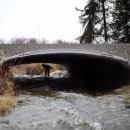About Us
The Lahontan Fish and Wildlife Conservation Office is located in Reno, Nevada and is one of three facilities within the Lahontan National Fish Hatchery Complex. Our office supports recovery and restoration of native fishes and their habitat across Nevada and Eastern California. Lahontan Fish and Wildlife Conservation Office also works with multiple partners to advance conservation of tribal resources, including the Pyramid Lake Paiute Tribe, Washoe Tribe of California and Nevada, and Walker River Paiute Tribe.
What We Do
Our biologists support recovery and restoration of native fishes and their habitat by:
- Managing the reintroduction of the lake form of Lahontan cutthroat trout in the Lake Tahoe, Truckee, Pyramid and Walker Lake Basins with our partners for conservation and recreational fishing.
- Managing Cui-ui recovery in Pyramid Lake in partnership with the Pyramid Lake Paiute Tribe.
- Managing and advancing conservation hatchery principles at Lahontan National Fish Hatchery.
- Lead for California-Great Basin Region National Fish Passage Program.
- Providing coordination and technical assistance for fish passage fish passage
Fish passage is the ability of fish or other aquatic species to move freely throughout their life to find food, reproduce, and complete their natural migration cycles. Millions of barriers to fish passage across the country are fragmenting habitat and leading to species declines. The U.S. Fish and Wildlife Service's National Fish Passage Program is working to reconnect watersheds to benefit both wildlife and people.
Learn more about fish passage improvement projects throughout the State of Nevada. - Researching and monitoring fish populations to ensure conservation and recovery strategies are achieved through time, often in collaboration with University researchers.
- Developing and managing in-stream flows in the Truckee River for cottonwood recruitment and migrating fish.
- Assisting with habitat improvement projects that work towards watershed connectivity in high priority conservation waters.
Our Organization
Our Species
Cui-ui (Chasmistes cujus)
Cui-ui were listed as endangered in 1967 and are believed to be the last genetically pure member of the lake sucker genus Chasmistes. They are a long-lived fish that are known to live up to 45 years of age and are only found in Pyramid Lake. They are obligate freshwater stream spawners.
Lahontan cutthroat trout (Oncorhynchus clarkii henshawi)
The Pilot Peak strain Lahontan cutthroat trout represents the original lake form that evolved in ancient Lake Lahontan and existed in the Truckee, Tahoe and Walker Lake Basins. Once thought to be extinct, transplanted Lahontan cutthroat trout were found in the Pilot Peak Mountains along the Nevada/Utah border in the late 1970s. Utilizing genetics of museum mounts from 1872 to 1911 of fish known to be from the Truckee River Basin, it was determined that the Lahontan cutthroat trout in the Pilot Mountains were descendants of the original Truckee Basin Lahontan cutthroat trout.
Through years of careful genetic management and refining conservation broodstock broodstock
The reproductively mature adults in a population that breed (or spawn) and produce more individuals (offspring or progeny).
Learn more about broodstock strategies, the genetic legacy of the original lake form Lahontan cutthroat trout was secured at Lahontan National Fish Hatchery. The Lahontan National Fish Hatchery Complex began stocking Pilot Peak Lahontan cutthroat trout into Pyramid Lake in 2006, in collaboration with the Pyramid Lake Paiute Tribe. True to their genetic potential, the Pilot Peak strain in Pyramid Lake exhibits life history traits found in the original population such as large size, long life span, late at reaching sexual maturity and piscivory.




